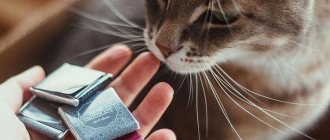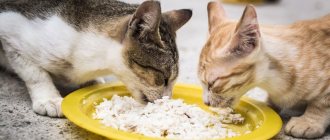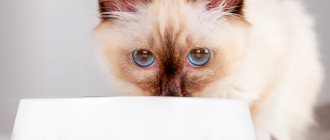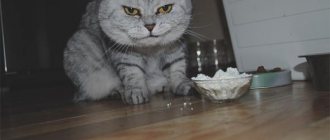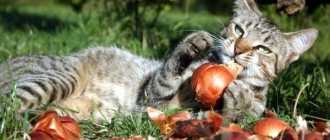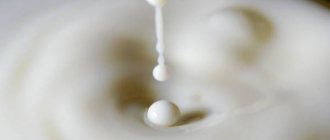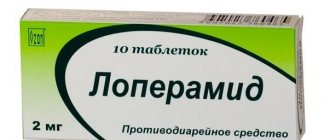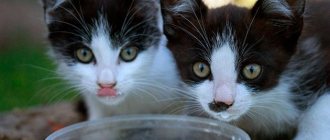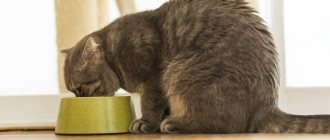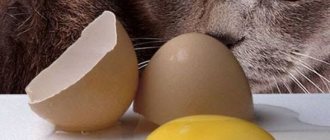Nutritional features of kittens
To answer the question whether a kitten can be given milk, you need to understand how its digestion works. From a scientific point of view, cats fall into the following categories:
- Class: Mammals;
- Squad: Predatory;
- Family: Felines.
Nature has provided that the best nutrition for a newborn kitten is its mother's milk. A mother cat, like a true mammal, feeds her babies with milk for up to 3 months. During this time, a special enzyme, lactase, is produced in the kittens’ small intestine, which allows them to digest lactose (milk sugar).
When the kitten is 1 month old, the mother begins to gradually introduce him to solid food. They try meat, but breastfeeding does not stop. We must not forget: cats are predators. The kitten's body is growing and preparing for adulthood. Instead of lactase, proteases begin to be produced - enzymes responsible for the breakdown of proteins.
By 3 months, the cat has finished breastfeeding the kitten, and it can be given meat food. Lactase is no longer produced because there is no need for milk.
Note: in very rare cases, the gastrointestinal tract of adult animals may retain the ability to produce small amounts of lactase and digest milk.
The right diet
In their natural environment, kittens feed on their mother's milk. Teenage cats usually go hunting at the age of three to four months. For a newborn kitten, its mother's milk is ideal. In its chemical composition, it differs significantly from cow's milk. It is cat's milk that contains all the necessary nutrients and microelements for the growth and development of a kitten. This food is fully digested and cannot harm the baby’s fragile body. But what to do if a mother cat cannot feed her babies? Is it possible to give a kitten cow's milk? This is not really a good nutritional option. Cow's milk is high in lactose, milk sugar. It is too sweet for cats, and if this product becomes the basis of the diet, it can harm the pet’s health.
How to tell if your cat is lactose intolerant
The main symptoms of lactase deficiency in cats are painful bloating, diarrhea and vomiting. Most often, unpleasant symptoms appear 8-12 hours after the animal consumes milk.
The following mechanism works in the cat’s body: she drinks milk, but lactose is not broken down by lactase and passes through the small intestine undigested. Next, milk sugar attracts water and ends up in the large intestine, where bacteria try to process it. At this time, carbon dioxide, hydrogen and other substances that cause fermentation are released.
Benefits and harms
Despite numerous statements by scientists about the indispensability of cow's milk, this product in the diet of pets is considered absolutely useless and even harmful.
Experienced veterinarians even advise owners of purebred animals to replace this product with dry or wet food that is more nutritious and beneficial for animals.
What is the uselessness and harm of milk:
- There are a lot of calories in a whole drink, and their excess in the body of cats can lead to metabolic imbalance, which will lead to obesity;
- the composition contains quite a lot of casein and lactose, which are poorly absorbed by the animal’s body;
- against the background of intolerance to the incoming components, the cat can very quickly develop an allergic reaction;
- very often, feeding cow's milk to adults ends in banal diarrhea, which can also turn into a chronic form, in which serious dehydration of the body is observed;
- in addition to stool disturbances, the cat develops flatulence, bloating and other painful symptoms.
This futility is noted when feeding adult cats. As for kittens, the diet of small pets must include milk, preferably natural mother's milk.
If there are insurmountable difficulties with breastfeeding, it is necessary to find a useful replacement that can bring undeniable benefit and not harm to the body of a growing animal.
Is it possible to give cow's milk to a kitten?
When thinking about whether to treat your kitten to milk, you should clearly understand that the composition of cow's milk is significantly different from cat's milk. It is cat's milk that contains the optimal amount of nutrients for the full development of the baby.
So, cat's milk consists of 8% protein, and cow's milk - 3.5%. The fat content of the former is also higher on average - 4.5% versus 3.3%. And this is not to mention vitamins and minerals.
The problem with milk from the store is its quality.
- When raising cows, antibiotics are used, which then end up in the milk and can lead to dysbacteriosis.
- If the milk comes from a pregnant cow, it will have a higher estrogen content, which can cause hormonal imbalance in the kitten.
- The plants that the animal ate may have been treated with pesticides. Standards for toxic substances are calculated for people, but not for tiny kittens.
- Store-bought milk is pasteurized, which reduces its nutritional value.
- In addition, cow's milk protein is a strong allergen.
Giving cow's milk to a kitten can be downright dangerous!
Until what age do kittens drink their mother's milk?
If you didn’t know, cats don’t produce milk right away. First, more liquid colostrum is released, but it is this that gives the cubs the necessary substances to gain immunity.
It’s hard to say how many times a day kittens drink milk, since both mother and children live according to their own schedule, which suits only them. But on average, kittens eat up to 12 times in the first week. And this needs to be taken into account if you have a very small lump in the house. In the first weeks, delay in feeding is dangerous for the baby's life.
Mom and baby
Further, the frequency of feeding gradually decreases and by the end of the first month, children eat 6 times a day.
Again, it is impossible to say until what age a cat feeds kittens with milk. Everything is very individual.
The duration of feeding depends on:
- Completeness of the mother's diet. During lactation, the cat needs more nutrition, as it eats for the entire “family”. Moreover, the menu must be balanced so that the litter receives all the necessary elements.
- The health and morale of the cat. During childbirth, the animal may receive psychological trauma and not recognize the cubs. Also, the mother’s nipples may be very sensitive, and then feeding will not last long.
- Number of “heirs” A cat has 6 nipples. Therefore, they can fully feed only 6 kittens. If there are more “people”, then the slowest and weakest kittens risk, if not dying of hunger, then significantly less than normal. Moreover, the more kittens, the sooner the cat closes its “dairy kitchen”.
On average, kittens are content with milk until about 2-2.5 months. But, as already mentioned, the deadlines can be either extended or shortened.
Goat and sheep milk
It must be admitted that goat and sheep milk is less allergenic than cow milk. If an adult cat has an intolerance to cow's milk, but you really want to treat it with milk, then this will be a good replacement.
As for kittens, ruminant milk does not cover their nutritional needs. Proteins and fats will not be enough, and, as a result, a kitten fed with goat's or sheep's milk will grow and develop slowly.
The lactose content in the milk of goats and sheep is higher than that of cats. Although kittens produce lactase, it is designed for cat milk.
Types of milk in a cat's diet
The most popular types of milk that owners can offer their pets are cow's and goat's.
Their comparative composition is given in the table.
| Index | Cow's milk | Goat milk |
| Fat content | 2,2 – 6,8 % | Average 4.5% |
| Vitamins | A; B1; B2; B6; B12; D; C. | A, D, E, C, B1, B2, B4, B5, B6, B12, H, PP, nicotinic acid. |
| Microelements | Calcium, potassium, phosphorus. | Calcium, potassium, phosphorus, magnesium, sodium, molybdenum. |
| Lactose content | High. | Minimal. |
| Calorie content, ml/100 g | 60 | 68 |
Despite the fact that goat milk has a high fat content, its composition is basically similar to cat and human breast milk, it contains more proteins, micro- and macroelements, and higher calorie content. At the same time, there is practically no alpha lipase, which causes the formation of fatty deposits.
Therefore, goat's milk is much preferable in pet nutrition than cow's milk:
- easier to digest;
- contains many lacto- and bifidobacteria, which improve digestion and gastrointestinal function;
- hypoallergenic, as it contains no proteins;
- minimal lactose content;
- lots of vitamins and minerals.
Is it possible to give milk to a fold-eared kitten?
A real “urban legend” associated with milk concerns British and Scottish fold kittens. It goes like this: if you feed lop-eared kittens with cow's milk, their ears may “stand up.” The main argument in favor of this theory is that kittens will receive a lot of calcium from milk, which will strengthen the cartilage and straighten their ears.
This myth is used by unscrupulous breeders. In fact, Scottish and British kittens' ears may rise as they grow. This is due to a defect in the breed, or it can be considered a feature of a particular animal. Fallow cats must receive calcium and other minerals.
The answer to the question whether it is possible to give milk to a fold-eared kitten will be the same as for other breeds - cat milk is ideal, but cow, goat and sheep milk is not recommended.
Is it possible to give dairy products to a kitten? Everything you wanted to know in one article
Do you want to treat your tailed friend with sour cream or kefir? You fill the third saucer with milk a day, but you doubt whether these products will be beneficial? Or will they harm? Can kittens have milk? After all, the body of our little brothers is a complex mechanism. Let's find out how to properly introduce dairy products into your pet's diet.
Can kittens have milk?
I think everyone will answer this question unconditionally “yes”. After all, in childhood, each of us fed street kittens with this “cat” treat. It’s difficult to argue with the fact that milk is very beneficial for a kitten’s growing body. But you need to take into account the fact that it will have the greatest benefit only in one case: if it is mother’s milk. At the initial stage of his life, when the baby is fed with her milk, the body produces the enzyme necessary for the breakdown of lactose - lactase. As you grow older and start eating solid foods, the amount of the enzyme decreases, which can lead to lactose intolerance.
The Internet is replete with articles about the dangers of milk and the need to completely exclude it from the diet. But is everything really so categorical? No, rather individually. Naturally, you can give your pet milk, but keep in mind:
- Milk can actually cause diarrhea, bloating and pain. If your kitten has this exact reaction, remove milk from the diet.
- Milk can be given to a kitten only up to 4 months. At this age, teeth change and the transition to solid food begins; now it will be difficult for the cat’s body to absorb milk.
- Cow's milk is inferior in nutritional value to cat's milk (720/930 kcal).
- You should not give your kitten store-bought milk. It is processed - the amount of useful substances is reduced. Give preference to natural and fresh. And don't forget to boil!
- Goat milk is easier to digest and contains more vitamins. If you are going to give it to your pet, dilute it with a small amount of water.
- The daily norm is 30 mg of milk per 100 grams of kitten’s body weight. Don't overdo it when trying to feed your pet!
Is it possible to give milk to a newborn kitten left without a mother?
Another situation is when you have a newly born baby in your arms. When a cat cannot feed him on her own, the question arises: is it possible to give milk to a newborn kitten? Don't rush to the store. Ideally, you should find a nursing cat that will replace the baby's mother. If you don’t have one, you can feed the baby yourself using various milk substitutes and powdered milk, which are sold in pet stores, but not with cow’s or goat’s milk.
You can often find references online that you should not give milk to fold-eared kittens. Too much calcium can cause their ears to straighten out. Don't believe these pseudoscientific facts. If your lop-eared pet begins to experience metamorphosis with its ears, milk has absolutely nothing to do with it. Don't trust armchair experts from the internet! Therefore, the answer to the question whether it is possible to give milk to a Scottish, British and any other kitten is yes, it is possible, if there is no stomach upset or other reactions to the product.
The question “can kittens have milk” has been sorted out, but what about other dairy products? Of course, they are food that is beneficial for intestinal flora. These products have a positive effect on the growth and development of teeth and bones, which is very important for our young cat. Don’t be afraid to include dairy and fermented milk products in your diet, and our tips will help you avoid mistakes.
Kefir.
- To prevent stomach problems due to the percentage of alcohol contained in kefir, let it sit for several days. Kefir should not be salty or sweet.
- Avoid low-fat kefir and high-fat kefir. Choose the average - 2.5%.
- You need to give kefir to your kitten 2-3 times a week.
Sour cream.
One of our cats' favorite treats. But you need to treat your pet with it carefully:
- Sour cream with a high percentage of fat content is harmful to the liver.
- Buy sour cream with the lowest fat content.
- You can give your kitten sour cream in small quantities 2 times a week.
Cottage cheese.
Very useful, especially for a growing body. It contains a large amount of calcium, which is also quickly absorbed.
- Buy cottage cheese with a fat content of less than 9%.
- The cottage cheese should be fresh and not very sour.
- Before giving cottage cheese to your kitten, add a spoonful of sour cream to it. Your pet will appreciate the delicious dish.
- Treat your baby to cottage cheese 3-4 times a week.
We hope we have helped you understand the intricacies of dairy products in the life of kittens. And now you know for sure whether kittens can have milk. And how to feed a kitten correctly.
Read our post What to feed a kitten: detailed instructions for beginning cat breeders and find out how to create the most healthy and nutritious diet for your baby.
Bon appetit to your pet!
Other interesting articles for you:
What and how to feed a cat so that it stays alive. An essential guide for cat owners!
How to quickly train a cat to use the litter box without going crazy: 7 simple steps
How to train a cat to use a scratching post, even if he completely ignores it. 7 simple steps
Microchipping cats: 7 popular questions
Raising and training cats: 6 effective tips
With love to you and your cats
Studio Four Cats
How to feed a kitten
There are life situations when a kitten loses its mother too early, or she cannot feed him. In this case, the best solution would be to feed him a special mixture - a cat's milk replacer. Cat food manufacturers offer mixtures whose composition is as close as possible to cat milk. The food should be diluted with water, according to the instructions, and the baby should be fed using a special nipple (at an angle of 45 degrees). As a last resort, you can use a syringe without a needle or a pipette.
For the first 21 days of life, feed the kitten every 2-3 hours, but do not force it to eat more than it wants. Cats about a month old are fed 4 times a day. Two meals are formula, the other two are wet food.
If for some reason you can’t buy a cat’s milk substitute, you can feed the kitten with baby food. Choose formulas for very young children and dilute them with more water than the rules written on the label.
In a critical situation, dilute goat's milk with water - it is preferable to cow's milk.
If the kitten is older than 3 months, it no longer needs to be fed and does not need to be given milk.
Options for replacement
Currently, many different milk replacers are produced, designed for pets of different breeds and ages. And every responsible cat owner should know how to replace milk if necessary. So, if a cat has an allergy or intolerance to this product, the following will come to the rescue:
- fermented milk products;
- infant formula diluted with water;
- a special balanced dairy product substitute that does not contain lactose, intended for cats with sensitive digestion. Currently offered by brands such as Beaphar (Kitty Milk), Gimpet (Cat Milk), Royal Canin (Babycat Milk).
Thus, the opinion of most veterinarians is that mustachioed pets are not prohibited from feeding low-fat milk if it is normally absorbed by the body. Cats with intolerance to it can be treated to fermented milk products, again, provided that their perception is normal. But in no case is it allowed to mix dairy products with ready-made feed.
Milk in the diet of adult cats
If your cat tolerates milk well and will never refuse it, even after listening to a lecture on lactose, calculate its daily intake of this treat: 10-15 ml per 1 kg of weight. If your cat doesn’t digest cow’s milk well, but the desire to pamper her with something delicious is irresistible, buy low-lactose milk from cat food manufacturers.
Important: dry cat food can only be combined with water. Do not try to diversify your “dry” diet with milk - this can lead to the formation of deposits in the bladder and kidneys, and increased stress on the liver and other organs.
If your pet eats “natural” food, you can treat her with fermented milk products. Give preference to low-fat cottage cheese, sour cream, fermented baked milk and kefir. Cheese should be low fat and unsalted. Pay attention to your pet’s well-being - let the treats bring only benefits!
Can cats have milk?
Almost no one with a mustache refuses such a delicacy. This, in turn, gives the cat owner a reason to think that his actions regarding the cat’s diet are correct. But before you feed your pet milk, you need to consider how this product affects the cat’s body.
Any cat drinks milk with great pleasure
Benefits and harms
Milk, although considered healthy, has its pros and cons.
The whole drink contains not only lactose, which is not digestible by adult pets, but also such useful substances as:
- B vitamins (thiamine, pyridoxine and riboflavin), vitamin C;
- minerals: potassium, calcium, magnesium, phosphorus, iodine, selenium, zinc;
- proteins and amino acids.
Note! Due to their lack, the health and immune system of the pet weakens, which leads to a decrease in resistance to various diseases and injuries.
Thus, the benefits of milk in relation to cat health are quite obvious. At the same time, one cannot ignore the negative aspects that may arise when feeding an animal with this product. So, why cats should not be given cow/goat milk:
- if a cat consumes a high-calorie product too often, it can cause obesity;
- contains lactose and casein in large quantities, they are poorly absorbed by the mustachioed body and can cause diarrhea, flatulence or constipation;
- due to intolerance to the above elements, in addition to stool disturbances and bloating, allergies may develop.
For your information! These negative effects are observed when feeding milk to adults. It must be present in the diet of small fluffies (preferably maternal).
Also, store-bought milk may contain various antibiotics and pesticides, which certainly will not have a beneficial effect on cats. The presence of harmful substances in the drink is associated with feeding cows/goats with industrial feed and hay. It is possible to contain drugs that are injected into cows/goats for preventive purposes in factories and farms.
Is it possible to have cow
The most popular types of milk that cat owners can offer their four-legged pets are goat and cow. But is it possible to feed kittens cow's milk? It is quite high in calories, so you can treat it to mustaches only if they do not have food intolerance to this product.
Cats mostly drink cow's milk, but it is quite fatty for their bodies.
Is it possible to goat
Can kittens have goat milk? Goat is lower in calories, but at the same time healthy and nutritious for the animal’s body. The proteins and fats it contains are easier to digest, so giving this product to a pet (adult and kitten) is acceptable.
Goat meat is lower in calories than cow meat
Note! Before giving milk to an animal, it must be boiled. This is necessary to get rid of possible microbes that could have entered the product through packaging during production.
Is it possible to give milk to a nursing cat?
Milk, cottage cheese, curdled milk and low-fat sour cream are an important component in the diet of a nursing mother cat. Therefore, to the question of whether lactating cats can be given milk, the answer is unequivocal - yes. After the babies are born, the mother’s menu must be supplemented with milk and products made from it, even if before that the cat did not like to eat them (which is very rare). Because by eating them, the newly minted mustachioed mother receives not only nutrients, but also the calcium necessary for the postpartum body.
You can give these products for testing on the third day after birth. After just a week, the animal should consume them daily (provided there are no food intolerances).
Dairy products are an important part of a nursing cat's diet.
Important! If, however, the cat is hypersensitive to this product, it should be excluded from the diet.
How to feed a kitten without a cat: Secrets of a dairy diet for babies
In what cases are newborn blind kittens left without a mother-nurse?
In what cases does the question arise, how to feed newborn kittens without a cat?
Sometimes it happens that a cat dies during childbirth or immediately after it.
It happens that for some reason she refuses to feed her offspring.
And sometimes the soulless owners of their four-legged pet can simply throw the offspring outside so as not to violate their comfort zone.
In any case, orphaned kittens can be saved, even if it is not possible to find a nursing cat and give her sucklings.
A wet nurse is, of course, an ideal option, but such an opportunity is not always available.
Caring for newborn kittens requires patience and some knowledge
The main thing is to properly ensure their maintenance. And this:
- arrangement of a cozy “nest” with heating; providing nutrition equivalent to mother's milk; proper care for babies, taking into account their physiological needs.
Nurse cat or artificial feeding
When deciding how to feed a newborn kitten without a cat, you need to understand that a wet nurse is the ideal solution for both the smallest kitten and its owner.
As a rule, a nursing cat accepts one or more babies easily.
The main thing is to know that the mother and her kittens are healthy and will not infect the babies with infectious diseases, in particular ear mites.
Important! Colostrum, which a cat feeds its kittens in the first two days, is usually not enough. If your kittens are older than those she is nursing, you will need to continue feeding the babies until the nurse begins to produce enough milk.
Preparing a place for keeping kittens
Under normal conditions, the cat independently provides its babies with the optimal temperature regime.
She warms the little kittens who are with her all the time.
Considering that the physiological norm for a cat’s body temperature is 38 degrees, when arranging a place for babies, it is important to take into account that in the nest it should be a little higher.
An electric or simple heating pad is suitable for heating; an infrared heater is perfect.
You can also use plastic bottles with warm water.
Of course, the water in a simple heating pad or bottle will have to be changed frequently.
But this will not be difficult, because small kittens have to be fed several times a day.
This way it will be easy to control the temperature.
It is best to wrap the bottle in a towel or terry cloth.
It is best to cover the nest with soft, non-synthetic fabric or baby diapers, which, unlike fabric, do not need to be washed.
When choosing between a cardboard box and a basin, it is better to choose a basin: a cardboard box can get wet and absorb odors.
Therefore, keeping small kittens in a basin or plastic box will be more hygienic.
A tray from a plastic carrying bag is also suitable for this purpose.
Houses for cats will also come in handy, only later: it is not entirely convenient to care for orphaned kittens up to the age of one month.
How often to feed kittens
Month-old kittens can already feed on their own.
But until this time, they will have to pay maximum attention, because they will have to be fed both during the day and at night every two to three hours.
Animals must be handled with extreme caution
The algorithm for feeding small kittens looks like this:
- up to two weeks of age, feeding every two to three hours without a night break; in the third and fourth weeks - every two to three hours during the day plus one night feeding; from the fifth to the seventh week - every three to four hours during the day, and night feeding is canceled as the babies grow older.
Cow's milk or formula?
Cow's milk is not the best option for a blind kitten, since its composition is significantly different from the composition of cat's milk.
In addition, it can cause allergies in kittens, resulting in redness of the skin and paws.
The ideal solution is dry mixtures, which can be purchased at veterinary pharmacies.
The mixtures have a balanced composition, which contains all the components necessary for the growing body.
Each package of powdered cat milk replacers Katzenmilch, Royal Canin BabyMilk, Gimpet Cat-Milk, Beaphar Kitty-Milk, Hartz contains a special bottle with a nipple.
Bottles with a nipple are very convenient when feeding kittens
How to make your own mixtures
If it is not possible to buy ready-made mixtures, you can prepare them at home yourself.
- 20% condensed milk diluted 1:5, bone meal (1 tsp per 1 liter of milk).
- cow's or goat's milk - 25 g glucose 5% (20 ml) milk powder - 5 g vitamin supplements - 1 g.
“Vitamin” mixture - recommended for weakened and sick kittens
- milk (100 ml) glucose 5% (20 ml) 1 yolk vegetable oil (1/2 teaspoon) Tetravit (about 0.3 ml) 2 teaspoons of infant formula “Nutrilon fermented milk”.
- cow's milk - 200 ml, vegetable oil - 1 teaspoon. spoon, egg yolks - 2 pcs., vitamins in drops (tetravit or trivit).
The ingredients of the mixtures must be mixed thoroughly and brought to a homogeneous mass.
Before feeding, the mixture is heated to 38 degrees.
The finished mixture should be stored in the refrigerator for no more than a day.
How to properly feed a blind kitten
To feed a one-week or two-week-old kitten, you need to purchase a pacifier and bottle from a veterinary pharmacy.
An ordinary medical syringe without a needle will also work.
You can use a rubber tip from a pipette, pierced with a hot needle and placed on a small vial.
It is better to feed a kitten up to one month of age from a nipple
Firstly, the sucking instinct is satisfied, and secondly, the risk of aspiration of the respiratory tract with milk or formula is reduced, which can lead to pneumonia.
Feeding from a pipette or syringe requires great care.
Since babies' immunity is still weak, any infection can be fatal.
Important! Cleanliness and sterility of nipples and bottles is an integral rule that must be strictly followed.
While the cub is eating, it is advisable to stroke its head and back and talk to it quietly.
There is no need to limit milk or formula - the suckling's face should be in milk, and the tummy should be rounded.
After feeding, it is advisable to hold the suckling upright.
When the blind kitten is full, he begins to fall asleep, and milk bubbles appear from his mouth.
He needs to wipe his face with a napkin soaked in warm water.
Many people are interested in whether it is possible to determine how much food the baby has received?
It’s possible - well-fed babies calmly fall asleep, but hungry ones get restless, crawl, and squeak.
If you give them a finger, they start sucking it.
How to determine if a kitten is fed enough
Advice! Both overfeeding and underfeeding are dangerous for both a week-old and a two-week-old kitten. We need to find a middle ground. Underfed kittens are lethargic or restless and do not gain weight. When overfeeding, problems with stool appear.
The main indicator of overfeeding is stool
If it is liquid and yellowish in color, this means that there is slight overfeeding.
With moderate overfeeding, the stool takes on shades of green.
Constant overfeeding is the cause of gray stools.
If the stool turns white, a veterinarian should be consulted to rule out infection.
Simple and important care tips
During the first 3 weeks, a nursing cat takes care of removing excrement and independently maintains the cleanliness of the nest.
As kittens grow up, they begin to leave their “calling cards” in certain places.
At the same time, the mother cat continues to lick them off with her tongue.
When kittens are bottle-fed, humans take on this mission.
And it doesn’t matter what kind of kids they are: both popular breeds of cats like the Persian, Neva Masquerade or Burmese cats, and simple mongrel creatures require the same care.
A light massage of the tummy clockwise in the area of the urethra and anus stimulates the passage of stool and urine.
After feeding and massage, the kitten should be wiped with a warm damp cloth and the diaper in the nest should be changed.
In such cases, you have to resort to an enema with cool water and a small amount of Vaseline oil.
Depending on the size of the kitten, the amount of water can vary from 1 to 5 ml.
Instead of a bulb, you can use a 5 mm syringe, the cannula of which is generously lubricated with baby cream or Vaseline.
Thus, the question that concerns many people, how to feed a newborn kitten without a cat, can be completely resolved.
Now it will be possible to think about vaccinations for kittens, and about further rules of care for both purebred and ordinary babies.
Love for our little brothers, care and affection, combined with the availability of free time, can work wonders.
These kids will definitely give you many pleasant moments and positive emotions.
How to feed a kitten without a cat if for some reason he is left an orphan? It is not easy to replace a baby’s mother, but if this happens, then patience, scrupulousness and certain knowledge will help save the lives of small defenseless creatures.
Why cats should not be given milk and why it is harmful
To be fair, not all cats can have milk. If your pet tolerates the product well and does not have an upset stomach or vomiting, then you can pour a drink for your purr once a week for him to enjoy. In other cases, especially if your cat is purebred, it is better not to give milk. Why, why? The fact is that purebred pets can react very poorly to milk protein due to their delicate stomach.
Something else interesting: How to properly feed a two-month-old kitten
Indeed, the drink does not have a very good effect on the gastrointestinal tract. Moreover, this liquid should not be given to animals that constantly eat dry food. Acting for the good, you will seriously harm your pet, since such food is combined only with water. If the cat constantly drinks milk, and the diet consists of dry food, this will lead to deposits in the kidney and bladder. Do not forget that other organs will also suffer.
What kind of milk can you give a cat?
Doubts about the benefits of milk arise for two reasons: lactose intolerance in some animals and an allergy to the milk protein casein. The latter pathology is rare in cats, but if it is identified and confirmed, all dairy products are excluded. Casein is not destroyed by boiling, pasteurization, fermentation, and allergies are not treated.
Also, you should not give milk along with dry food, this will cause digestive upset and impair the absorption of nutrients.
Lactose intolerance is more common, but not in all cats. The enzyme lactase is responsible for the breakdown of disaccharides. It is produced in kittens from birth. With the transition to solid food, the formation of the enzyme decreases or stops.
In adult cats, the production of lactase varies, so some drink milk without consequences, others develop dysbiosis, and others tolerate milk safely if they eat little and infrequently.
The animal's reaction is determined experimentally. At first they give you no more than a sip to try. If vomiting, constipation, or diarrhea occurs, milk is excluded. In the absence of a negative reaction, the portion is gradually increased and the amount to be given to the animal is determined without harming health.
When feeding, the following restrictions are observed:
- The daily norm is 10–15 ml per 1 kg of weight.
- Suitable fat content is 2.5%.
- Before feeding, milk is brought to room temperature.
- They don’t boil a steam room when they know for sure that the cow is not sick.
- It is not necessary to boil store-bought; it arrives on the shelves after heat treatment.
- Goat or sheep milk is easier to digest and is suitable for cats with allergies to cow's milk protein. There is no casein in it.
Of the 200 components, calcium, amino acids, omega fatty acids, and vitamins are of value to cats. If the pet does not tolerate milk in its pure form, try feeding it fermented. It is not inferior in composition, and the consequences occur less frequently due to fermented lactic bacteria, which partially break down lactose.
Here are the dairy products you can give to cats:
| Products | Benefits for cats |
| Pairs | Valuable components are preserved in their natural form |
| Pasteurized | Does not contain harmful bacteria, micronutrients are partially lost |
| Ghee up to 3.5% fat content | It is better absorbed and no harmful microbes remain in it. When processed, the amount of vitamins, iron, calcium, phosphorus increases |
| Curdled milk | Contains lactic acid bacteria, which support the gastrointestinal microflora and normalize metabolism |
| Biokefir | Includes bifidobacteria, they improve digestion, create a favorable environment in the intestines for the absorption of calcium, vitamin D, iron, and prevent the spread of harmful microflora |
| Ryazhenka | In terms of nutritional value and benefits for the stomach, it is not inferior to kefir, but has a gentler effect on the gastrointestinal tract |
| Natural yogurt | Probiotics prevent digestive disorders and suppress pathogenic microflora |
| Lactose-free | Lactose is contained in a split form, so it is easily absorbed |
| Cottage cheese up to 9% fat | The amount of calcium is superior to other dairy products |
| Sour cream up to 10% fat | Fermented milk fungi have a beneficial effect on intestinal flora, fats improve the condition of the coat |
Is it possible to give a cat smecta?
Can cats be given grass?
Is it possible to give meat to a cat?
Dairy proteins cannot replace meat proteins, so the diet should not consist of dairy products alone.
Ready-made feed
If you have to feed newborn kittens, be sure to purchase a cat's milk replacer. It is much better for a small pet than cow food, since it will provide all the necessary components. You can choose any of the formulations that suit your price, for example, Royal Canin, Hartz, Nutri-Vet, Camon, Dolfos, Gimborn. Whiskas rations are useful for this purpose.
For castrated cats, it is best to choose a diet containing milk, but make sure that the total daily calorie intake is met. Otherwise, if the animal constantly eats such food, it is very possible that it will gain excess weight.
Of course, you yourself determine exactly how you will feed your fluffy, but do not forget that his body is also individual. Take a closer look at whether your furry pet is allergic to certain foods, how the stomach perceives it, and whether vomiting or diarrhea occurs. Thus, outbred village cats have such good immunity that they can easily lap up milk drinks and absorb them perfectly.
Do cats need dairy products?
The need to include fermented milk products and milk itself (less often) in a cat’s diet is dictated by a set of their useful components, such as:
- lactose;
- unique amino acids;
- animal protein;
- microelements;
- fatty acid.
Lactose – glucose and galactose molecules are involved in the birth of this natural carbohydrate. Natural sugar is found in all dairy products, including kefir, cottage cheese, whey and milk itself. If lactose is not absorbed by the body, this is a problem for a particular cat, but not for all whiskered cats.
Amino acids - there are only 20 of them, and 8 of them cannot be replaced with artificial or herbal supplements.
Animal protein - it also cannot be synthesized industrially or find an equivalent analogue in the plant world.
Microelements – in dairy products they are maximally balanced. Potassium and calcium need the help of phosphorus, and sodium is “ready” to disintegrate only under the “pressure” of other trace elements. You won’t be able to outwit nature by adding pharmaceutical preparations with sodium/calcium to your food: in their pure form they will provoke the deposition of kidney stones.
Fatty acids - they give milk (and its derivatives) a pleasant taste, contain vitamins A and D, lecithin and cholesterol, without which the body cannot live. Cholesterol is involved in the “release” of vitamin D and is involved in many hormonal processes.
Fermented milk products
They are introduced into the diet when the cat’s stomach has a negative reaction to pure milk, giving priority to kefir and cottage cheese. The latter is especially rich in calcium, which is responsible for the health of the coat and bone tissue, including teeth and claws.
Fermented milk products can be divided into 2 groups:
- obtained by lactic acid fermentation - yogurt, bifidok, cottage cheese, fermented baked milk, yogurt, sour cream;
- produced by mixed fermentation (lactic acid + alcohol) - kumiss and kefir.
“Sour milk” of the first group can be served on the cat’s table immediately, of course, if it has an expiration date.
Before treating your cat with kefir, take a look at the date of manufacture: the older the product is, the stronger its strength and the higher the proportion of carbon dioxide. Young kefir contains no more than 0.07% ethyl alcohol, while mature kefir contains approximately 0.88%.
In this case, biokefir, which has a softer taste and added probiotic bacteria (usually acidophilus bacillus), will come to the rescue. Probiotics balance the microflora, and diarrhea/constipation becomes a thing of the past.
Fat content of fermented milk products
The cat is fed dairy products, without going beyond a certain percentage of fat content:
- cottage cheese – up to 9%;
- curdled milk, kefir, fermented baked milk, natural yogurt – up to 3.5%;
- sour cream - 10%, but it must be diluted (1/1) with warm water.
All cheeses are usually very fatty, which is why they are contraindicated for cats. The exception is unsalted varieties such as the Adyghe one, but these are also given infrequently and in small portions.
We must remember that cats, like people, have different health conditions, and the same product can cause diametrically opposed reactions in them. Sometimes even low-fat fermented milk products provoke diarrhea, however, they should not be replaced with low-fat ones. Just eliminate the product that causes stomach upset.
